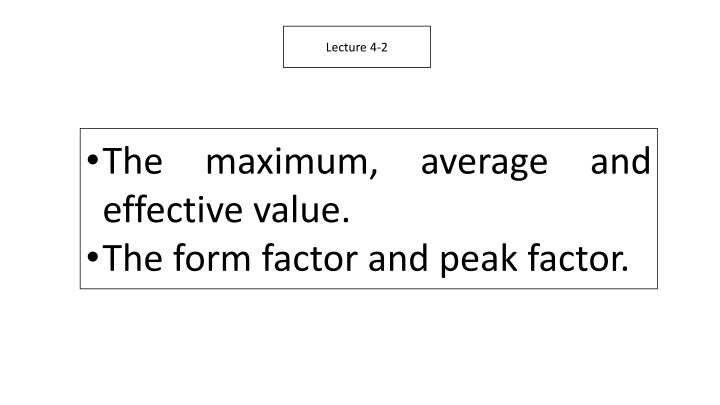
AC Electricity: Maximum, Average, and Effective Values
Explore the concepts of maximum, average, and effective values in AC electricity, along with form factor and peak factor. Learn how to calculate the effective (rms) value and understand the processes involved in determining it. An example with an Ironing Machine's behavior is provided for practical understanding.
Download Presentation

Please find below an Image/Link to download the presentation.
The content on the website is provided AS IS for your information and personal use only. It may not be sold, licensed, or shared on other websites without obtaining consent from the author. If you encounter any issues during the download, it is possible that the publisher has removed the file from their server.
You are allowed to download the files provided on this website for personal or commercial use, subject to the condition that they are used lawfully. All files are the property of their respective owners.
The content on the website is provided AS IS for your information and personal use only. It may not be sold, licensed, or shared on other websites without obtaining consent from the author.
E N D
Presentation Transcript
Lecture 4-2 The maximum, average and effective value. The form factor and peak factor.
1.5 1 0.5 Current (A) 0 0 5 10 15 20 -0.5 -1 -1.5 Time (ms) To explain this equation let: ??= 1?, Then ??? ? = 1 0.6 ???=1 2 1 0.4 2cos2?? Since the average value of the second term 1 2cos2?? equal to zero, then the only constant term ?2?? 2 will represent the dissipated power during the heating process time. 0.2 Power (W) 0 0 5 10 15 20 -0.2 -0.4 -0.6 Time (ms)
Note: Three processes are done on the AC current in the above derivation to find its effective value, these are: 1. The AC current is squared. 2. The average value of the squared current is adopted. 3. The effective current determined by finding the square root of the mean of the squared current. Hence, the effective value of the AC sinusoidal current is the root of the mean of its square value, so it is known as the rms value .
Example: Let us consider the behavior of an Ironing Machine ( ) as a pure resistive load of 1kW power supplied by a single phase AC voltage of (220V, 50Hz) for domestic application. The supplied voltage can be represented mathematically as: ? ? = ????sin ?? Since its rms value is 220V, then its maximum value (????) is: ????=???? 2 ????= 220 2 = 311.127V Then ? ? = 311.127sin ?? Since, ? =(????)2 ? 2202 1000 ? ==(????)2 = = 48.4 ? Then ????=???? =220 48.4= 4.546A ? The time domain function of the current ? ? is already known as:
Example: Let us consider the behavior of an Ironing Machine ( ) as a pure resistive load of 1kW power supplied by a single phase AC voltage of (220V, 50Hz) for domestic application. The supplied voltage can be represented mathematically as: ? ? = ????sin ?? Since its rms value is 220V, then its maximum value (????) is: ????=???? 2 ????= 220 2 = 311.127V Then ? ? = 311.127sin ?? Since, ? =(????)2 ? 2202 1000 ? ==(????)2 = = 48.4 ? Then ????=???? =220 48.4= 4.546A ? The time domain function of the current ? ? is already known as:
? ? = ????sin ?? Then ????= 2 ????= ? ? = 6.429sin ?? 2 4.546 = 6.429A In time domain and due to Kirchhoff's Voltage Law (KVL) in a closed circuit ???????+ ?????= 0 Also, ???????? + ?????? = 0 Or ?????? = ???????? Then ?????? = 311.127sin ?? And from the previous derivation, the time domain function of the power is: ???? =????2? 2 6.4292 48.4 2 ???? = 1000 1000cos2?? Now, the time domain functions or the instantaneous values of: 1. the source and load voltages 2. the supplied current 3. the consumed power Are determined and can be represented as follows: ????2? 6.4292 48.4 cos2?? 2 ???? = cos2?? 2
Source and Load voltages Load Current 350 300 8 250 6 200 4 150 Current (A) 100 Voltage (V) 2 50 0 vs(t) 0 0 5 10 15 20 -50 -2 0 5 10 15 20 vR(t) -100 -4 -150 -6 -200 -250 -8 -300 Time (ms) -350 Time (ms) Instantaneous Power 2500 2000 ?? ?? ?? Power (W) 1500 1000 500 0 ???= ???= ?2 ? = 4.5462 48.4 = 1000W 0 5 10 15 20 Time (ms)
The Form Factor and Peak Factor Since, the effective value or the (rms) value is ??+? 1 ? 2?? ????= ? ? ?? And the average value is: ??+? ???=1 ? ? ? ?? ?? Then the Form Factor ?? is: ??=???? ??? Also, the Peak Factor or Crest Factor ??=???? ????? Hence, for any sinusoidal function like AC current or Voltage ??? ?????=???? ???? ??=???? ???=0.707???? 0.637????= 1.11 ??=???? ???? ????= 0.707????= 1.414















